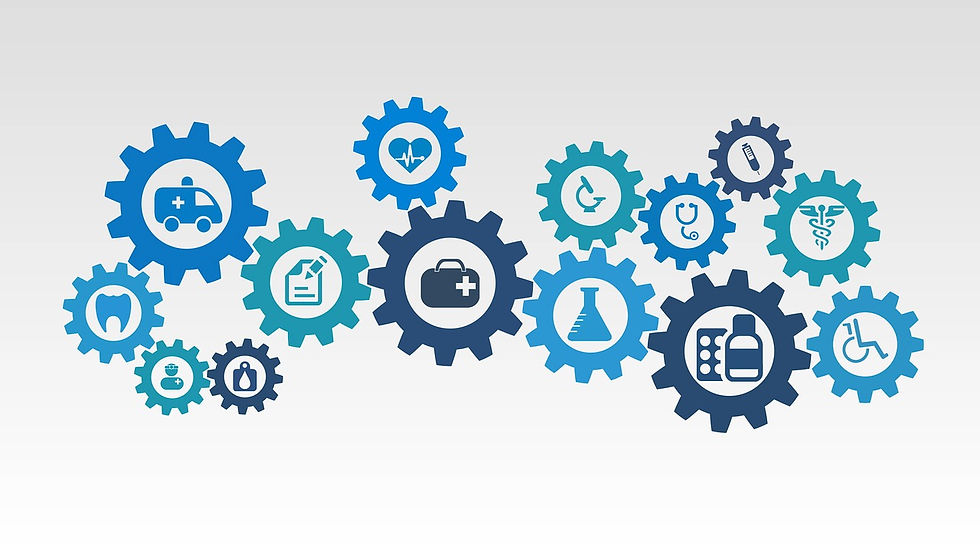Registered Dental Hygienists and the Canadian Health Care System
- ALeeRDH

- May 11, 2019
- 4 min read
Updated: Aug 1, 2019

I am a registered dental hygienist (RDH) in Nova Scotia. I am licensed and regulated by the College of Dental Hygienists of Nova Scotia and am also a member of the Canadian Dental Hygienists Association.
In Canada, RDHs can be found in various positions. Examples of common positions include:
- Clinical Dental Hygiene - employed by a dentist
- Clinical Dental Hygiene - self-employed, independent practice
- Public Health
- Education
Where do I fit into this?
I am both a clinical dental hygienist employed by a dentist and a clinical instructor at Dalhousie University as a part of the education system. I will elaborate further on my role in the health system as a clinical dental hygienist, as this is impacted by the health care system.
Legislative background
The College of Dental Hygienists of Nova Scotia (CDHNS) regulates RDHs through registration, licensing and discipline processes. RDHs in Nova Scotia are governed by the Dental Hygienists Act. According to the Dental Hygienists Act (2007) the CDHNS regulates the profession of dental hygiene in the province by:
"(i) the registration, licensing and disciplinary processes established pursuant to this Act and the regulations,
(ii) establishing, maintaining and developing standards of practice for members,
(iii) establishing, maintaining and developing standards of professional ethics for members, and
(iv) establishing, maintaining and developing standards for the education, knowledge, qualifications, professional responsibility and competence of its members and applicants for membership"
(Dental Hygienist Act, 2007)
As a member of the Canadian health care system, it is my responsibility to collaborate with other Health Care Professionals (HCP) to treat patients comprehensively. Rules and regulations relating to collaborative and comprehensive care of patients in Nova Scotia can be found in the Regulated Health Professions Network Act (2012). This document describes the regulations and responsibilities all HCPs within the province must follow. To learn more about how RDH collaborate with other health professionals, check out my Professionalism Audit.
How does the Canadian health care system fund dental hygiene care?
Dental Hygiene clinical care is primarily a privately funded sector of health care. The Canada Health Act "establishes criteria and conditions related to publicly funded insured health services and extended health care services that the provinces and territories must fulfill to receive the full federal cash contribution under the Canada Health Transfer (CHT)." (Health Canada, 2019, p. 7). The only publicly funded treatment relating to oral health available for all residents of Nova Scotia are dental surgeries provided in a public health care facility.
Specific populations in Nova Scotia can receive limited dental hygiene care funded by the province; The three main programs are Nova Scotia Children's Oral Health Program funded by Medical Service Insurance (MSI), Income Assistance (IA) for individuals who are the age of majority in Nova Scotia and meet the eligibility criteria, and Non-Insured Health Benefits (NIHB) for Indigenous people who meet the eligibility criteria.
Nova Scotia government dictates the dollar amount to be covered for those dental hygiene services insured by MSI, IA and NIHB. The Nova Scotia Department of Health and Wellness issues a Fee Guide that states the fees covered for MSI. Indigenous Services Canada in collaboration with the NS government create an annual fee guide for NIHB. The Employment Support and Income Assistance Policy Manual outlines fees covered for IA.
Dentists employing RDHs in private practice have the freedom to increase their fees, however, and this difference is paid out-of-pocket. Independent RDHs have a separate list of codes for the same procedures they would perform under the employ of a dentist. There currently isn't a fee guide for these codes, though they are often lower than those in a dentist's office. The issue, however, is that independent dental hygiene codes are not accepted by MSI of IA; The CDHNS has been fighting for this since self regulation in 2009.
So what about the rest of the population?
Given that government funding for dental hygiene care is limited, there are other strategies being implemented by the Government of Canada. Educating the public is one of the most important factors to prevent oral health issues. The Government of Canada website provides information for proper oral hygiene care at various stages of life to prevent oral disease; It also recommends visiting a dental professional regularly for dental/dental hygiene care. The interval and extent of care will vary greatly depending on the individual's oral health status and home-care routine. Individuals are responsible for the fees associated with their dental/dental hygiene treatment, whether that takes the form of a benefit plan (employee or private), out-of-pocket expense or both.
The CDHNS recognizes that more can be done for the public. In 2014, the CDHNS published a White Paper titled "Dental Hygienists Prevent More to Treat Less". This position paper served to identify the need for policy change to improve the health of Nova Scotians. RDHs promote prevention and with the recommendations outline in this White paper, there is hope to improve the oral health and overall health of Nova Scotians.
References:
Canadian Dental Hygienists Association. (2019). CDHA National List of Service Codes 2019 Edition. Retrieved May 15 2019 from https://www.cdha.ca/cdha/The_Profession_folder/Independent_Practice_folder/National_List_of_Service_Codes/CDHA/The_Profession/Independent_Practice/Service_Codes.aspx
College of Dental Hygienists of Nova Scotia. (2014). Dental Hygienists Prevent More to Treat Less. Retrieved May 15 2019 from www.cdhns.ca/images/Prevent More to Treat Less OCTOBER 2 FINAL.pdf
Department of Finance. (2011, December 19). Canada Health Transfer. Retrieved May 12 2019 from https://www.fin.gc.ca/fedprov/cht-eng.asp
Government of Canada. (2018, December 17). Taking care of your teeth and mouth. Retrieved May 14 2019 from https://www.canada.ca/en/public-health/services/taking-care-your-teeth-mouth.html
Government of Nova Scotia (2019, March 1) ESIA Program Policy Manual. Retrieved May 17 2019 from https://www.novascotia.ca/coms/employment/documents/ESIA_Program_Policy_Manual.pdf
Health Canada. (2019, March 18). Canada Health Act Annual Report 2017-2018. Retrieved May 11 2019 from https://www.canada.ca/content/dam/hc-sc/documents/services/publications/health-system-services/canada-health-act-annual-report-2017-2018/canada-health-act-annual-report-2017-2018-eng.pdf
Indigenous Services Canada. (2019). Nova Scotia NIHB Regional Dental Benefit Grid
Dental Hygienists. Retrieved May 17 2019 from https://provider.express-scripts.ca/documents/Dental/Dental%20Benefit%20Grids/2019/Nova%20Scotia/NS%20HY%20-%20Dental%20Benefit%20Grid%20%28Mar%201-2019%29.pd
Nova Scotia Department of Community Services. (n.d.). Income Assistance. Retrieved May 14, 2019, from https://novascotia.ca/coms/employment/income_assistance/index.html
Nova Scotia Department of Health & Wellness. (2019, Jan) Dental Facts: Children’s Oral Health Program. Retrieved May 14 2019 from https://novascotia.ca/dhw/healthy-development/documents/DentalFactsMSIChildren_En.pdf
Nova Scotia Legislature. (2007). Bill No. 24: Dental Hygienist’s Act. Retrieved May 14 2019 from https://nslegislature.ca/sites/default/files/legc/statutes/dentlhyg.htm
Nova Scotia Legislature (2012) Bill No. 147: Regulated Health Professions Network Act. Retrieved May 14 2019 from https://nslegislature.ca/legc/bills/61st_4th/1st_read/b147.htm



Comments